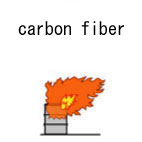| Case Name |
Fire in an electrical graphitization furnace for carbon fiber production |
| Pictograph |

|
| Date |
May 6, 1990 |
| Place |
Kawasaki, Kanagawa, Japan |
| Location |
Chemical factory |
| Overview |
At research and development facilities for pitch-based carbon fibers, a fire occurred at an electrical graphitization furnace for carbon fiber production where spun pitch fibers were baked at a high temperature. A crack was caused in the post nozzle by stress corrosion due to the chlorine concentration of cooling water and stress concentration. Cooling water leaked into the furnace, a water gas reaction between water and carbon occurred, and carbon monoxide and hydrogen were formed. It is presumed that these flammable gases ignited and burned outside the furnace, and a fire started. |
| Incident |
At a pilot plant where research and development were conducted on pitch-based carbon fibers, a fire occurred in an electrical graphitization furnace in which a pitch fiber that had been spun was baked at a high temperature to produce a carbon fiber. |
| Processing |
Research and development |
| Process Flow |
Fig2.Unit process flow
|
| Chemical Reaction |
Other |
| Substance |
Hydrogen, Fig3 |
| Carbon monoxide, Fig4 |
| Carbon fiber |
| Type of Accident |
Fire |
| Sequence |
This furnace was maintained at 2500 °C from May 2nd, 1990 for baking, and baking ended in the early morning of May 5th, when it entered a standby condition for the next round of baking.
About 19:25 on May 5th: At a field inspection, no abnormality was found near the graphitization furnace.
About 19:39. An abnormality alarm was confirmed.
About 19:40. A fire was confirmed at the site.
About 19:41. Fire extinguishing started soon using dry chemicals.
About 19:56. A private fire brigade turned out.
About 19:58. The cooperation disaster prevention crew started to spray water onto the building's roof for cooling.
About 20:00. The public fire brigade started to spray water for cooling.
About 21:26. Water spraying was stopped.
21:57. The fire was confirmed to be extinguished. |
| Cause |
A crack was generated at the post nozzle of an electrical graphitization furnace. Cooling water of the jacket leaked inside the furnace, and a water gas reaction between carbon and water occurred in the furnace, and hydrogen and carbon monoxide was formed. Generated combustible gas ignited, and also burned outside the furnace. It is considered that the crack was generated in the nozzle by stress concentration and stress corrosion cracking caused by the concentration of chlorine contained in cooling water. |
| Response |
Fire extinguishing at the initial stage with dry chemicals.
Preventing the spread of the fire by spraying water onto the building's roof. |
| Countermeasures |
Pure water is used for cooling water. Stress concentration is reduced by improving the structure. The carbon monoxide concentration in the furnace is monitored. |
| Knowledge Comment |
There is a hazard of a water gas reaction due to contact of carbon with cooling water in a water-cooled furnace. Austenitic stainless steel has a hazard of a stress corrosion crack when it comes into contact with cooling water containing chlorine at a high temperature. |
| Background |
It seems that there was a problem in the selection of materials and in cooling water properties in the outer cooling part of the furnace, which bakes at 2530 °C. AS industrial water with 20 ppm chlorine was used, it is necessary to assume a stress corrosion crack in SUS316 depending on the temperature. Since records are insufficient, there are a lot of uncertainties; for example, what was the designed maximum temperature of cooling water, or how precisely was the possibility of the chlorine concentration due to flow stagnancy examined?
Considering the material and the temperature, it was expected a water gas reaction takes place when water leaks.
A more prudent study was necessary as newly developed technology was involved. |
| Incidental Discussion |
From industrial water, only dirt is removed, so it contains various dissolved materials. Naturally, it also includes oxygen and chlorine. It readily causes corrosion because corrosiveness increases under a high temperature and a concentration cell is formed by the adhesion of precipitation to a wall. These studies are important. |
| Reason for Adding to DB |
Example of fire of hydrogen generated from a water-gas reaction due to contaminated water in an electrical graphitization furnace |
| Scenario |
| Primary Scenario
|
Insufficient Analysis or Research, Insufficient Prior Research, Research of Usage Environment, Organizational Problems, Poor Staff, Poor Experiment of Staff, Planning and Design, Poor Planning, Poor Material Design, Bad Event, Chemical Phenomenon, Concentration, Failure, Fracture/Damage, Stress Corrosion Cracking, Secondary Damage, External Damage, Leakage, Bad Event, Chemical Phenomenon, Abnormal Reaction, Secondary Damage, External Damage, Fire
|
|
| Sources |
High Pressure Gas Safety Inst. of Japan, Carbon fiber production experimental equipment, Graphitization electric furnace fire, Accident examples of Petroleum refinery and Petrochemical unit, pp.200-202(1995).
|
| Multimedia Files |
Fig3.Chemical formula
|
|
Fig4.Chemical formula
|
| Field |
Chemicals and Plants
|
| Author |
OGAWA, Terushige (Graduate School of Environment and Information Sciences, Yokohama National University)
TAMURA, Masamitsu (Center for Risk Management and Safety Sciences, Yokohama National University)
|
|